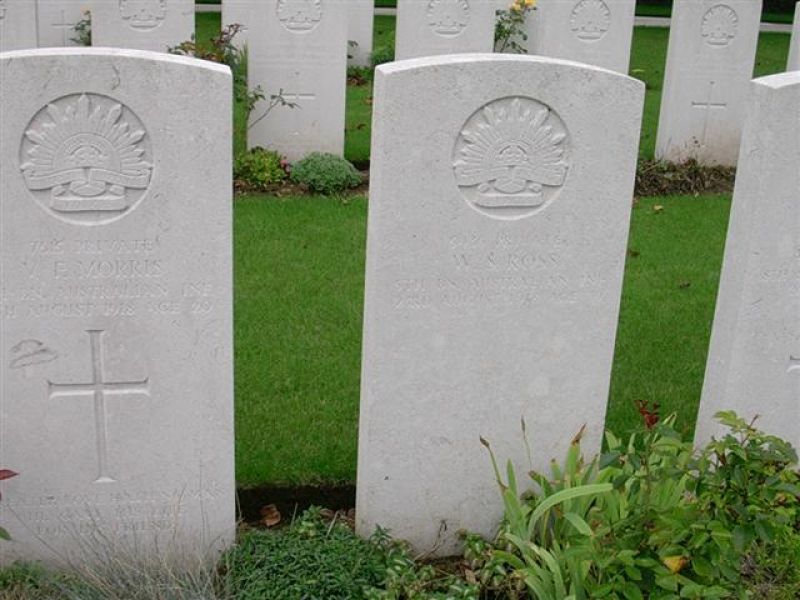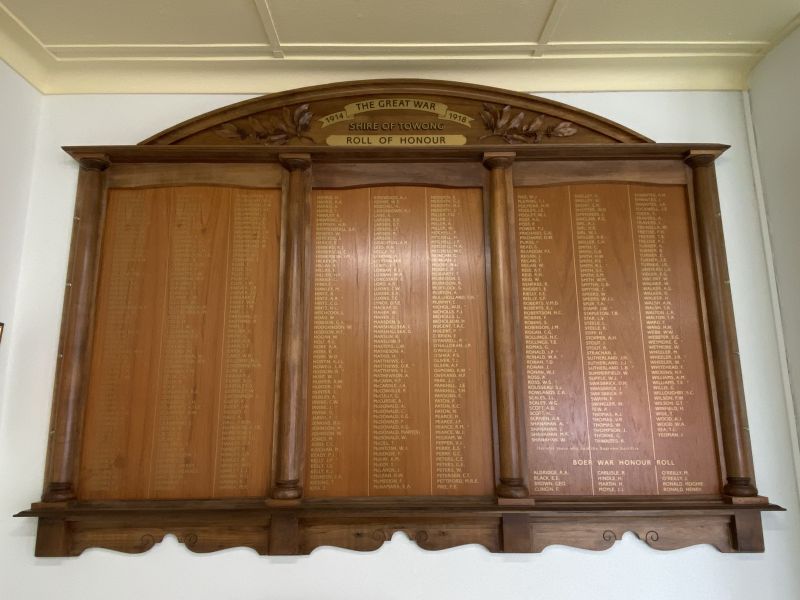William Stirling Ross
William was born in August of 1878 at South Alloa, in Stirlingshire, Scotland, to William and Isabella (née Barrie) Ross. William’s only sibling, Isabella, was born two years earlier. Both Isabella and William were born when their parents were in their late 30’s. In 1881, William’s father was listed as being a public housekeeper in Ferry Road. By 1891 the family had moved to 117 Kilbagie Street, Kincardine on Perth, and William senior was working as a railway goods porter.
Information supplied by William’s father for his Roll of Honour details provide some background knowledge about William before he left for Australia. He was educated at the Borough School, Alloa, Scotland. His father states that Willam’s calling was that of an Architect, a very different profession to the one William gave on his enlistment papers. Finally, we also know that he was an apprentice with J Melvin of Alloa. John Melvin was a well-known architect in Scotland and established the firm of John Melvin and Co in Alloa. Unfortunately, he suffered from continued ill health and died at the age of 50 in 1905.
Not much was known of William’s travels until he enlisted on the 21st of March 1916. His profession was given as storeman and bootmaker while his address was Main Street, Tallangatta. William was allocated the Regimental Number 5436 and initially placed into the 18th Reinforcements for the 5th Battalion, 2nd Brigade of the 1st Division. At nearly 38 years of age, William was older than the average age of recruits in 1916, which was 26.
His first month as a recruit was spent at the 20th Depot Battalion at Castlemaine in central Victoria. After a little under three weeks, he was transferred to Broadmeadows Army Camp to join the 18th Reinforcements for the 5th Battalion. On the 3rd of July, 1916, the 18th Reinforcements embarked on HMAT A33 Ayrshire at the Port of Melbourne and departed for England. They disembarked at Plymouth on the 2nd of September of that year and were immediately posted to the 2nd Training Battalion at Perham Down in Wiltshire, England. Further training was undertaken here until the 3rd of February 1917, when they were sent to France.
From the 12th of July to the 4th of August, William was temporarily attached to the 3rd Company of the Australian Service Corps.
On the 18th of January 1918, William was admitted to the 2nd Australian Field Ambulance. It was discovered that he had contracted a venereal disease. He spent two days at the 2nd Australian Casualty Clearing Station before joining Ambulance Train No. 32 to be sent to the 39th General Hospital and Havre. William spent a total of 55 days in hospital recovering. While he was in hospital the 5th Battalion were helping to repel the German Spring Offensive.
William rejoined his battalion towards the end of April 1918. One month later he was back in hospital suffering from inflamed lymph glands. He had recovered sufficiently to rejoin his unit on the 3rd of June. The following day the 5th Battalion relieved the 9th Battalion in the front line. Whilst in the line the battalion participated in numerous patrols, both during the day and night. Casualties were taken. Time was spent occupying the front line trenches and then spending a few days in the reserve trenches. The last couple of weeks of June were spent in camps behind the front line. Training continued as did working parties moving materiel and repairing trenches.
The first two weeks of July were spent in the forward areas and front line while the last half of the month was in camp near Racquinghem. The tour in the forward area was uneventful and it allowed the battalion to have a much needed rest. While in camp the troops were able to rest and frequently went bathing in the nearby channels. On the 27th of July an incident occurred which caused much unrest in the rank and file. The 5th Battalion was kept in the pouring rain for the purpose of being reviewed by the Army Commander. He never turned up and the men were soaked to the skin.
August for the 5th Battalion was to be the polar opposite of the previous month. Between the 7th and 9th of August the battalion moved to Bayonvillers and prepared themselves to participate in the Amiens offensive. During the fighting on the 9th and 10th the battalion suffered 20 O.R. killed, 2 missing inaction and 80 wounded. They were withdrawn from the line and placed in Divisional Reserve, being relieved by two battalions of the American 132nd Regiment. The following six days were spent resting and reorganising in the Hamlet area.
On the 22nd of August the battalion took part in the operation that would involve the 1st Australian Division. The 5th Battalion were to advance on the left of the line, through St Martins Woods, being supported by the 7th Battalion. On the right of the line the 6th Battalion would attack with the 8th Battalion being their support. At 0445 the attack began under cover of an artillery barrage. A number of tanks were allocated to the attack, but these were late getting into position so the battalion advanced without them (although they would prove useful when they reached the German trench line). As the battalion advanced into the woods, they came under heavy machine gun fire. William was hit and killed instantly.
William was initially buried where he fell. After the armistice he remains were re-interred in the Heath Cemetery in Picardie, France. He is remembered on the Australian War Memorial Roll of Honour, and the Towong Shire Boer War and WW1 Roll of Honour. For his service during the First World War, he was awarded the British War Medal and the Victory Medal.
Williams' story does not end there. In his attestation papers he claims that he was single. In early February of 1924, Base Records in Melbourne received the following letter.
“Jan th30/1924
81 Regent St
City
Sydney
To Base Records,
Melbourne
Dear Sir
I am placed in a very unfortunate position regarding my husband Mr William Stirling Ross whom I have lately heard has been killed in action during the last year of the war. [sic] and none of letters ever reached him. [sic] or his parents. His parents are living in Scotland and they recently wrote and told me that he had been killed in the war I went over to the Repatriation also to the Barracks they told me to write to the above address as I am his lawful wife I would very much like you to furnish me with what information you can if you could possibly do anything for me you would greatly oblige
E Ross
P.S. I don’t know where he enlisted from he was always a good husband before he went away.”
William’s wife, Ellen, received a letter from Base records asking her to supply some details on her husband including her marriage certificate.
Ellen wrote again to Base Records on the 18th of February.
“81 Regent St
City
Feb th18/1924
To Base Records,
Dear Sir
I am enclosing my fathersinlaw [sic] letter. he [sic] is a very aged man now. My Husband [sic] people have lived in the same place all their lives Honest respectable My Husband was the same he never neglected to write. to [sic] his parents what ever statement he has left will be correct. [sic] he would only speak the truth he was always a good Husband, A father I will be able to explain how my letters did not reach him. we [sic] are always sad about him trusting we will be able to find something about him
Yours respectfully
E Ross.
The above letter not only refers to William as a husband but also a father. No other correspondence between Ellen and Base Records can be found in William’s service records.
Further investigations reveal that William S Ross married Ellen M Tancred in 1906 at Marrickville, New South Wales. They had a child, a son, born on the 30th of January 1907. Ellen would have been about 16 at the time of the child’s birth. The New South Wales Police Gazette for the 28th of October, 1908 includes the following entry;
"Redfern - A warrant has been issued by the Redfern bench for the arrest of Willian Sterling Ross, charged with wife desertion. He is 30 years of age, 5 feet 11 inches high, thin build, dark complexion, hair and moustache, brown eyes, dressed in dark clothes and black hard hat; a Scotchman; a labourer. Last heard of in Lithgow 12 months ago. Complainant, Ellen Ross, 99 Raglan-street Waterloo."
This may explain the wording of Ellen’s second letter to Base Records. While the letter was written six years after William's death and 16 years since he left Ellen and their young son, it indicates her desire to understand what had happened to her husband.

 Stephen Learmonth
Stephen Learmonth